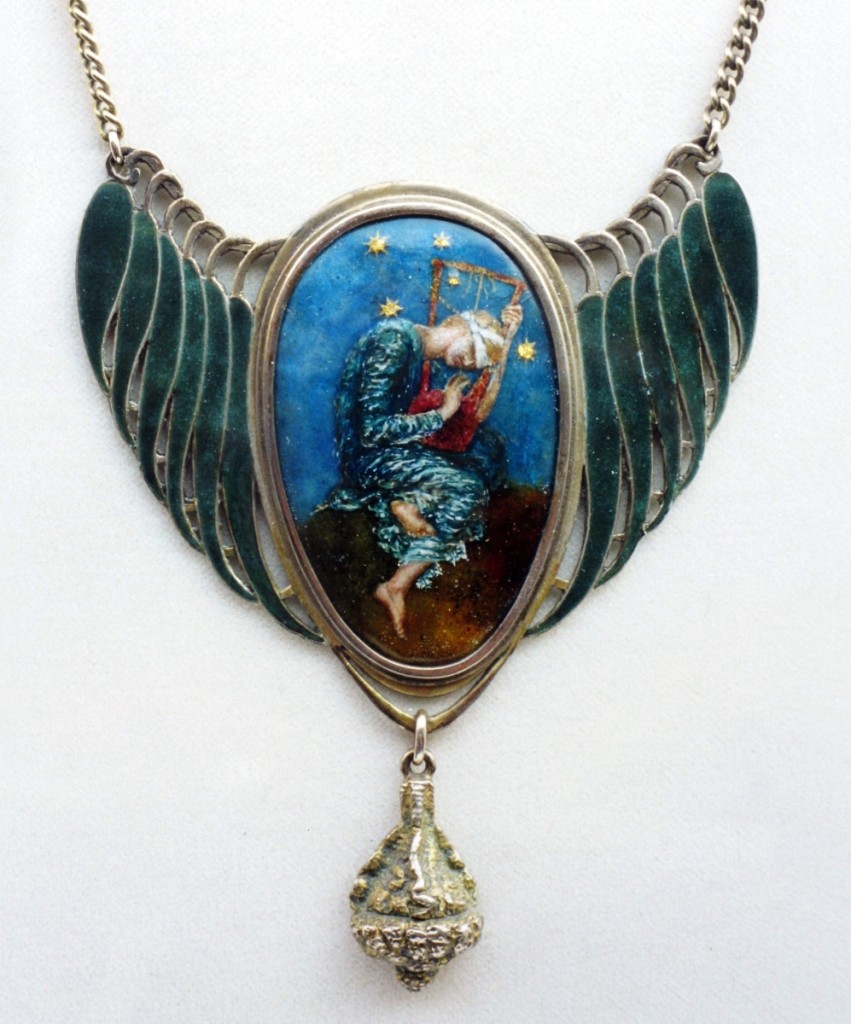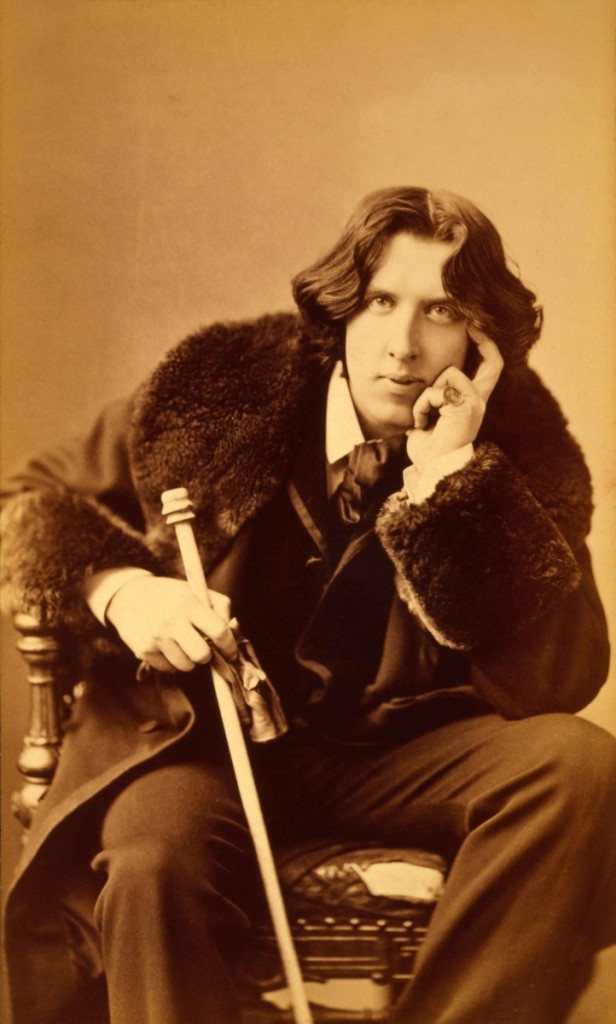
Symbolist pendant, unknown maker after “Hope” by George Frederic Watts (1817–1904), circa 1895. Enamel and silver. The collection of Richard H. Driehaus, Chicago. Photo courtesy Tadema Gallery.
By Karla Klein Albertson
NEWPORT, R.I. – “Bohemian Beauty: The Aesthetic Movement and Oscar Wilde’s Newport” is an exhibition of furniture, decorative arts, paintings and costumes on view in the Galleries at Rosecliff in Newport through November 4. Ashley Householder, curator of exhibitions at the Preservation Society of Newport County, spoke with Antiques and The Arts Weekly about the inspiration behind the project: “We liked the idea of doing this exhibition here because three of our properties have these beautiful high Aesthetic interiors: Chateau-sur-Mer, Kingscote and the Isaac Bell House. We’re lucky enough to have a number of decorative arts in our collection that reflect the creativity going on at that time. We thought it was especially compelling because Oscar Wilde, an important figure in the British Aesthetic Movement, came through Newport on his great American lecture tour in 1882 and spoke about the decorative arts at the Casino Theatre, which is just up the street from us on Bellevue Avenue. We thought we could do a wonderful Aesthetic Movement exhibition and also have this lovely tie-in with Oscar Wilde.”
Although the show does not have its own companion volume, a comprehensive overview of this influential artistic period can be found in the 1986 Metropolitan Museum of Art exhibition catalog, In Pursuit of Beauty: Americans and the Aesthetic Movement, still readily available from online booksellers. The distinguished reference has many authors, but in the opening chapter, Roger B. Stein, professor of art history at the University of Virginia, defined the subject: “The term ‘Aesthetic Movement’ describes a period of extraordinarily rich artistic activity in the United States in the last third of the Nineteenth Century, centered in the decorative arts in the 1870s and 1880s but expressed as well in American painting, in architecture and planning, in public and private collecting, and in art education in schools, museums and on the printed page.” The volume goes on to discuss at length the workshops and artists who produced the sort of objects we see again in the Newport exhibition, and to pay tribute to the figures at home and abroad who inspired their creation, Wilde among them.
The Oscar Wilde (1854-1900) who showed up in Newport in 1882 was only a 27-year-old Oxford graduate, known for his poetry and for the fashionable costumes he wore in public. He was yet to marry and have children or to write his influential plays, such as The Importance of Being Earnest (1895). And he was free of the pain and persecution of his final years, so movingly depicted in the 1997 film Wilde with Stephen Fry in the title role. In 1881, Gilbert and Sullivan wrote a comic opera, Patience, which made light of the vogue for aestheticism; the production had great success in London at the newly built Savoy Theatre. The central characters, rival poets Bunthorne and Grosvenor, were based on proponents of the movement, such as Wilde, Algernon Charles Swinburne and Dante Gabriel Rossetti – so they asked Wilde to embark on an American lecture tour to promote the musical on this side of the Atlantic.
 Householder explained, “He was an established poet in England at the time and had been proselytizing about the Aesthetic Movement since he was an undergraduate at Oxford. He had taken up the message of surrounding yourself with pure beauty, to lead a more beautiful life. Gilbert and Sullivan’s agent was also Oscar Wilde’s agent. Richard D’Oyly Carte was promoting a new comic opera – Patience – that was going to debut in New York that fall, and it was his idea to send Oscar Wilde on this tour to promote the opera. But because Wilde was so enamored with the Aesthetic Movement and was recognized as a popular part of the movement, the face of the movement, he took the opportunity to spread his own message of aestheticism.”
Householder explained, “He was an established poet in England at the time and had been proselytizing about the Aesthetic Movement since he was an undergraduate at Oxford. He had taken up the message of surrounding yourself with pure beauty, to lead a more beautiful life. Gilbert and Sullivan’s agent was also Oscar Wilde’s agent. Richard D’Oyly Carte was promoting a new comic opera – Patience – that was going to debut in New York that fall, and it was his idea to send Oscar Wilde on this tour to promote the opera. But because Wilde was so enamored with the Aesthetic Movement and was recognized as a popular part of the movement, the face of the movement, he took the opportunity to spread his own message of aestheticism.”
Today, consumers have reality television – perceptive guys hold forth on personal style and attractive couples tell everyone how to spruce up their houses. In 1882, the face of such advice came in the form of a popular personality on the lecture circuit. One lady would write another, saying, “You must see this man – it was like he was speaking only to me.” Lord Alfred Douglas, whose relationship with the writer caused turmoil in Wilde’s later life, published a tell-all book in 1914, written in an I-dated-a-celebrity vein. Oscar Wilde and Myself does offer some insight into the aesthete’s personal appeal in society: “With women he succeeded a great deal better than with men…. I think that women loved him because he would insist that everything was ‘charming’ or ‘exquisite,’ and because, although he was expected to talk brilliantly, he really did a great deal of listening.” A man who listens and wants to discuss his feelings – every woman’s dream.
On the 1882 tour, Wilde would eventually give 140 lectures in 260 days. One gallery in the exhibition is devoted to that tour and his visit to Newport. The Newport Historical Society has in its collection one of the invitations sent out advertising his appearance at The Casino on Saturday evening, July 15, at eight o’clock. It states that he will speak on: “The Decorative Arts: The practical application of the principles of the aesthetic theory to exterior and interior house decoration with observations upon dress and personal ornaments.” There is an account of the arrival of wealthy Cornelius Vanderbilt II (1843-1899) and his wife, Alice Claypoole Gwynne (1845-1934), who would build The Breakers in 1893. An original program from the Gilbert and Sullivan comic opera Patience is on loan from the Providence Athenaeum. Other exhibits outline his connection to Julia Ward Howe (1819-1910), who hosted him in Newport. Howe wrote poetry, essays and the lyrics to “The Battle Hymn of the Republic” and was a strong advocate for women’s rights.
Householder noted that the exhibition serves to raise awareness of the Aesthetic Movement: “Even though, it was a fairly short-lived style, it was incredibly influential as an important moment in design history and an important moment for interior decoration. This artistic movement that began in England affected Americans through the 1876 Centennial Exhibition in Philadelphia and then found its way to Newport. The residents here were among the wealthiest people in the country, and they could have done their homes in any style – money was no object – and three cottage owners chose Aesthetic interiors.” As a backdrop for the objects on display, the curator has covered the walls with reproductions of wallpapers used in two of those residences, Chateau-sur-Mer and the Isaac Bell House.

Oscar Wilde (1854–1900) was only 27 years old when he undertook his ambitious American tour, on which he presented 140 lectures on the decorative arts in 260 days.
Wilde said, “One should be a work of art or wear a work of art,” so not surprisingly costumes are an integral part of the exhibition. In the Long Gallery, there is a model draped in an elegant silk kimono robe, taken from the Preservation Society’s own collection, that illustrates the important role of Japonisme in Aesthetic design. Lilies, cherry blossoms, cranes and fans were among the decorative motifs borrowed from Eastern prototypes. Another gallery has six dresses, four pieces borrowed from the Ohio State University Historic Costume and Textiles Collection and two gowns by Mario Fortuny (1871-1949) from the Preservation Society. Householder added, “One of the topics we touch on in the exhibition is about reform clothing during this period. Men involved in the movement were among the proponents of this new way of dressing for women. Oscar Wilde was one who argued for a different silhouette.” Wilde’s own distinctive outfits were part of the thrill of his appearance on the lecture stage.
Other important exhibits are on loan from the collection of Richard H. Driehaus and the Richard H. Driehaus Museum in Chicago, housed in a Gilded Age mansion; the latter provided the Herter Brothers cabinet and the portrait of Luna. “Beauty’s Legacy: Gilded Age Portraits in America,” an exhibition exploring the fine art of this era, will be on view there September 8-January 6.
After his lecture tour, Oscar Wilde went back to England and expanded his writing career to include fiction and stage plays. He remains best known for his comedic takes on the social customs of his day: Lady Windermere’s Fan (1892), An Ideal Husband (1895) and The Importance of Being Earnest (1895). The 2002 film adaptation of the latter, featuring Colin Firth and Rupert Everett in the lead roles, is a celebration of Wilde’s talent at its witty best.
The Galleries at Rosecliff are located at 548 Bellevue Avenue. For more information, www.newportmansions.org.



















